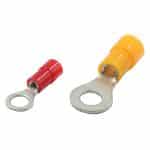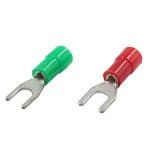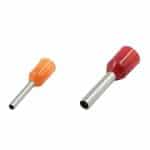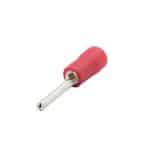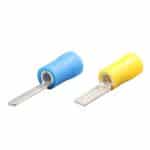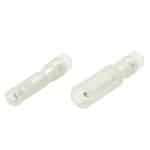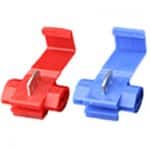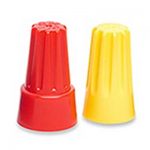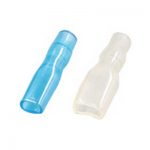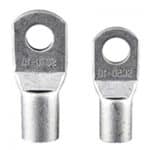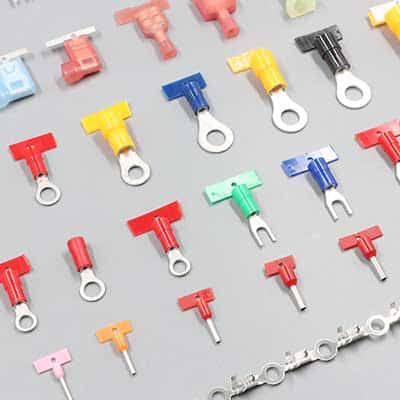
Crimp connectors, often referred to as wire terminals, encompass a wide array of essential electrical components. From heat shrink butt connectors to wire nuts, ferrules, wire lugs, quick disconnect terminals, ring terminals, pin terminals, bullet connectors, fork terminals, wire splice connectors, blade terminal and more, these connectors play a pivotal role in ensuring secure and reliable electrical connections across various industries. As a connector manufacturer with more than twenty years of experience, Scondar can provide a variety of reliable crimp connectors. We can provide a one-stop solution for reliable electrical connections for your project.
Characteristics: Quick disconnect terminals, also known as quick-connect terminals or spade connectors, consist of a male and female terminal pair that can be quickly mated and disconnected. They feature a flat, blade-like male terminal and a corresponding socket or receptacle.
Advantages: Enable rapid and tool-free connections and disconnections, saving time and effort during installation and maintenance. Quick disconnect terminals also provide a secure electrical connection.
Uses: Widely used in automotive, appliance, and industrial applications for connecting wires to switches, relays, motors, solenoids, and other components that require frequent servicing or replacement.
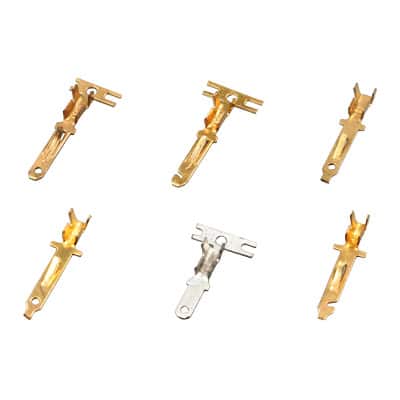
Male Spade Connector
Series: 110/187/250
Insulated Type: PVC/Nylon/PC/Non-Insulated
Wire Gauge: AWG #10 to #24
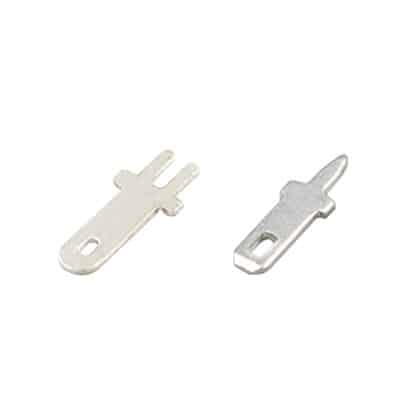
PCB Tabs
Series: 110/187/250
Insulated Type: Non-Insulated
Tab Thickness: 0.5mm to 0.8mm
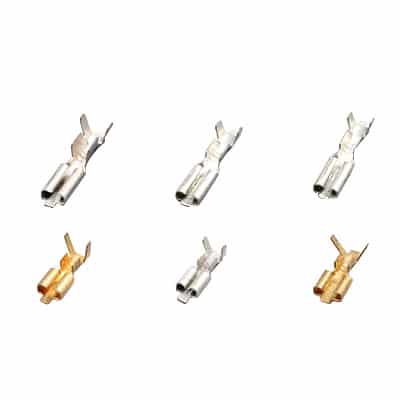
Female Spade Connector
Series: 110/187/205/250
Insulated Type: PVC/Nylon/PC/Non-Insulated
Wire Gauge: AWG #10 to #24
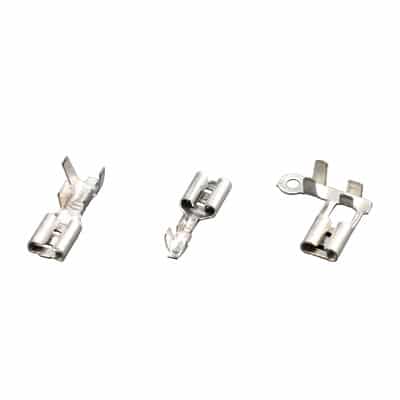
Female Spade Connector with Lock
Series: 110/250
Insulated Type: Nylon/PC/Non-Insulated
Wire Gauge: AWG #14 to #24
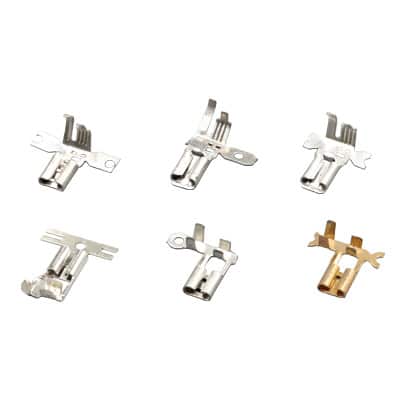
Flag Terminal
Series: 187/250
Insulated Type: Nylon/Non-Insulated
Wire Gauge: AWG #10 to #24
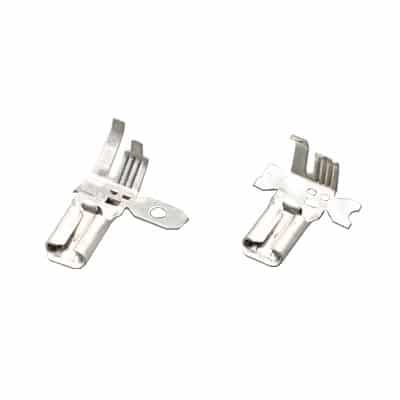
Flag Terminal with Lock
Series: 250
Insulated Type: Non-Insulated
Wire Gauge: AWG #14 to #20
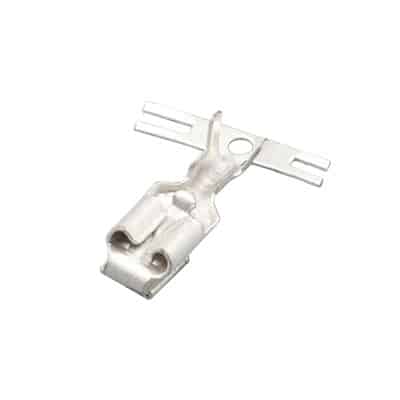
Piggyback Spade Connector
Series: 187/250
Insulated Type: PVC/Nylon/Non-Insulated
Wire Gauge: AWG #10 to #22
Characteristics: Spade connectors, also called fork terminals, feature a flat, fork-like metal blade that is inserted into a corresponding terminal block or stud. Spade to spade connectors have spade terminals on both ends.
Advantages: Enable quick and easy connections without the need for soldering, provide a secure and reliable electrical connection, and allow for easy disconnection when necessary.
Uses: Commonly found in automotive, marine, and industrial electrical systems for connecting wires to terminal blocks, switches, relays, and circuit breakers.
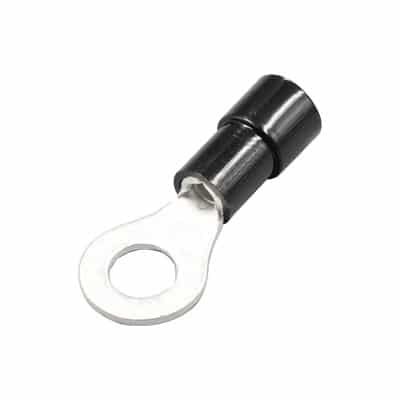
Ring Terminals
Insulated Type: PVC/Nylon/PC/Non-Insulated
Wire Gauge: AWG #2 to #26
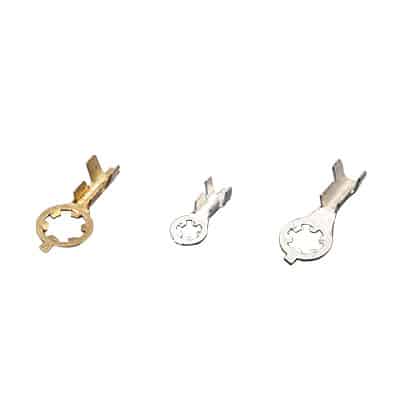
Star Ring Terminal
Insulated Type: Non-Insulated
Wire Gauge: AWG #12 to #20
Characteristics: Fork terminals, also known as fork connectors, feature a flat, fork-like metal blade that is crimped or soldered onto the end of a wire. They are designed to be inserted into a corresponding terminal block or stud.
Advantages: Provide a secure and reliable connection, especially in applications where there is a risk of wire pullout, vibration, or movement. Fork terminals also allow for easy installation and removal.
Uses: Commonly used in automotive, marine, and industrial electrical systems for connecting wires to terminal blocks, switches, relays, and other components where a secure connection is needed.
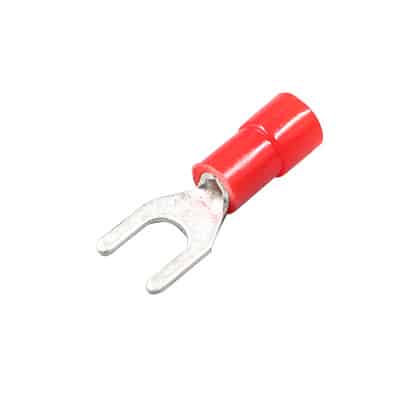
Fork Terminals
Insulated Type: PVC/Nylon/PC/Non-Insulated
Wire Gauge: AWG #8 to #24

Flanged Spade Terminals
Insulated Type: PVC/Nylon/Non-Insulated
Wire Gauge: AWG #10 to #22
Characteristics: Ferrules are metal or plastic sleeves crimped onto the stripped end of a wire. They typically have a barrel-shaped design and are available in various sizes to accommodate different wire gauges.
Advantages: Enhance wire flexibility, prevent wire fraying, improve conductivity, and create a secure termination point.
Uses: Commonly used in industrial, automation, and electrical panel wiring to terminate stranded wires, especially in applications where vibration or movement is present.
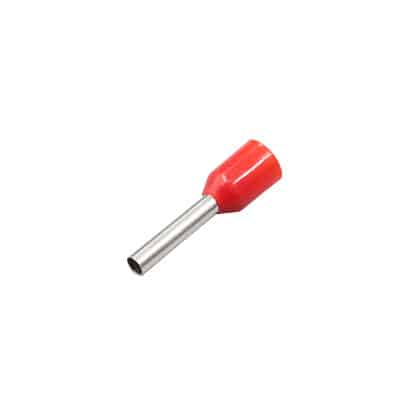
Wire Ferrules
Insulated Type: Nylon/Non-Insulated
Wire Gauge: AWG #4/0 to #28

Twin Wire Ferrules
Insulated Type: Nylon
Wire Gauge: 2*0.5 to 2*16mm²
Characteristics: Pin terminals are cylindrical metal connectors with a solid or hollow pin that is crimped or soldered onto the end of a wire. They are designed to be inserted into a compatible socket or terminal block.
Advantages: Provide a reliable and secure connection, suitable for high-current applications, and compatible with various terminal blocks and connectors.
Uses: Commonly used in industrial control panels, automotive wiring harnesses, and electronic equipment for connecting wires to terminal blocks, relays, and sensors.
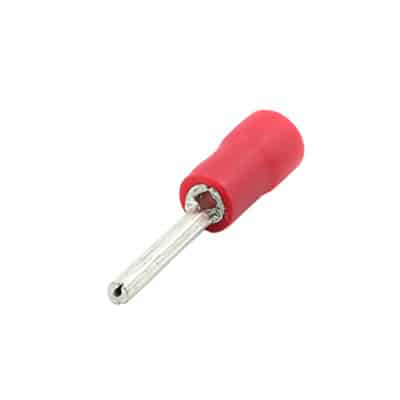
Pin Terminals
Insulated Type: PVC/Nylon/PC/Non-Insulated
Wire Gauge: AWG #3/0 to #22
Characteristics: Blade connectors, also known as spade connectors, feature a flat metal blade terminal that is inserted into a corresponding terminal block or receptacle. They come in various sizes and designs to accommodate different applications.
Advantages: Enable quick and easy connections without the need for soldering, provide good electrical conductivity, and allow for easy disconnection when necessary.
Uses: Found in automotive, marine, and household electrical systems for connecting wires to switches, relays, fuses, and other components.
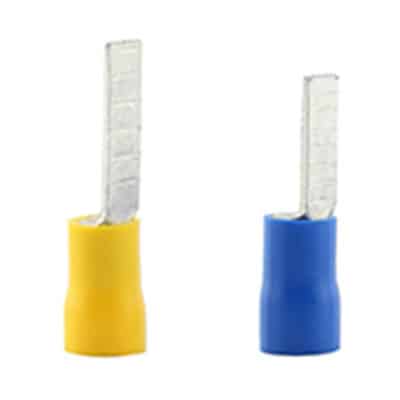
Blade Terminals
Insulated Type: PVC/Nylon/Non-Insulated
Wire Gauge: AWG #6 to #22
Characteristics: Bullet connectors consist of cylindrical male and female terminals that are inserted and mated together to create an electrical connection. They often feature a spring-loaded mechanism to ensure a secure connection.
Advantages: Enable quick and easy connections without the need for tools, provide good electrical conductivity, and allow for easy disconnection when necessary.
Uses: Widely used in automotive, motorcycle, and marine electrical systems for connecting wires to lights, sensors, switches, and other components.
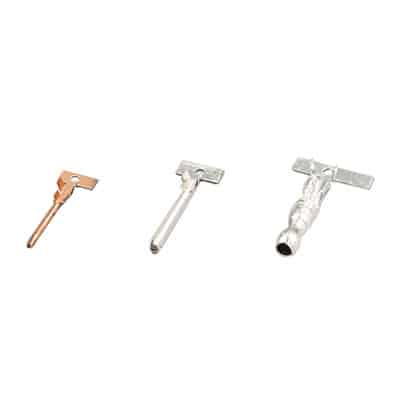
Male Bullet Terminals
Insulated Type: PVC/Nylon
Wire Gauge: AWG #10 to #24
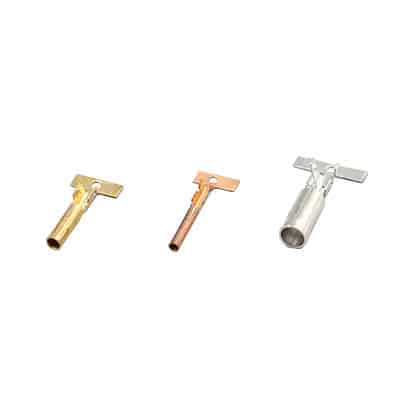
Female Bullet Terminals
Insulated Type: PVC/Nylon
Wire Gauge: AWG #10 to #22
Characteristics: Butt connectors are cylindrical metal or plastic terminals designed to join two wires end-to-end. They often feature a crimping or soldering mechanism to securely connect the wires.
Advantages: Provide a secure and reliable electrical connection, maintaining conductivity and minimizing the risk of short circuits or electrical hazards.
Uses: Commonly used in automotive, marine, and electrical wiring applications where a straight-line connection between wires is required.

Butt Connectors
Insulated Type: PVC/Nylon/Non-Insulated
Wire Gauge: AWG #4/0 to #26
Characteristics: Wire splice connectors are devices designed to join two or more wires together in a single connection point. They often feature insulation and a crimping mechanism to securely hold the wires in place.
Advantages: Provide a simple and effective method for joining wires without stripping insulation, suitable for both solid and stranded wires, and offer good electrical insulation and strain relief.
Uses: Used in automotive, household, and electrical wiring applications where multiple wires need to be connected together, such as repairing broken wires or extending wire lengths.
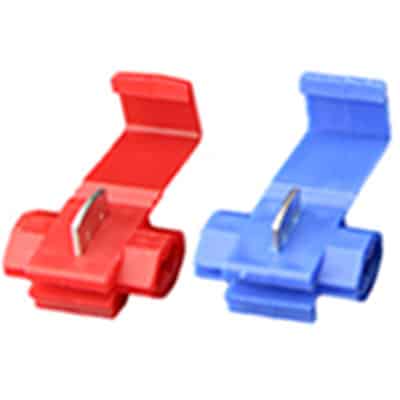
Quick Splice Connectors
Wire Gauge: AWG #12 to #22
Characteristics: Wire nuts, also known as twist-on wire connectors, are insulated caps with internal threads designed to twist onto the ends of wires to secure them together.
Advantages: Easy and quick to install without special tools, provide good insulation and strain relief, suitable for temporary or permanent connections.
Uses: Widely used in residential and commercial electrical wiring for connecting electrical wires in junction boxes, switches, outlets, and light fixtures.
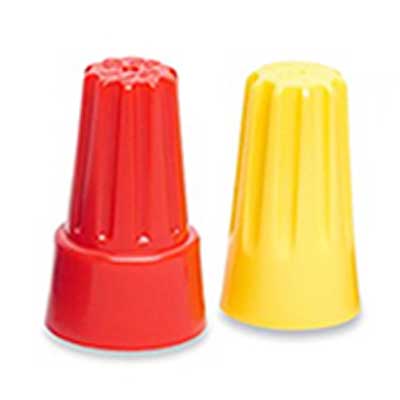
Wire Nuts
Color: Gray, Blue, Orange, Yellow, Red
Characteristics: Insulated tubes made of plastic or rubber, used to cover the ends of electrical connections, providing extra protection and insulation.
Advantages: Reduce the risk of short circuits and electrical faults, prevent damage and loosening of wire ends, prolonging connection life.
Uses: Widely used in automotive, aerospace, electronics, and household appliances to protect and insulate electrical connections, ensuring stability and reliability.
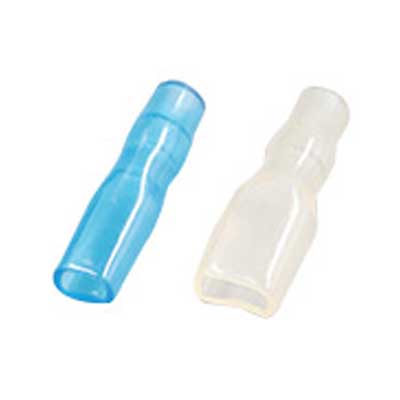
Terminal Sleeves
Series: 110, 187, 205, 250
Characteristics: Wire lugs, also known as cable lugs or crimp terminals, are metal connectors with a hole for attaching a bolt or screw. They are crimped onto the end of a wire to create a secure connection.
Advantages: Provide a strong and durable connection, suitable for high-current applications, and compatible with various terminal blocks, switches, and electrical devices.
Uses: Used in electrical panels, power distribution systems, automotive applications, and machinery to terminate large-gauge wires securely.
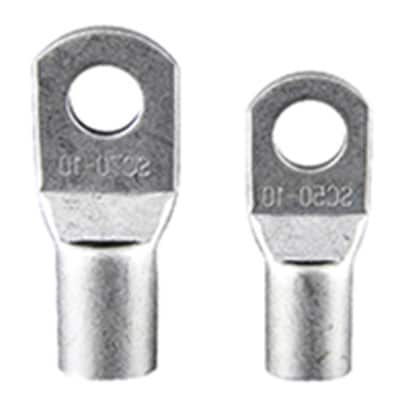
Wire Lugs
Wire Gauge: 1.5 to 630mm²

Wire Lugs Two Hole
Wire Gauge: 6 to 150mm²

Right-Angle Wire Lugs
Wire Gauge: 6 to 150mm²
The Evolution and Versatility of Crimp Connectors in Electrical Applications
Crimp connectors, often referred to as wire terminals, encompass a wide array of essential electrical components. From heat shrink butt connectors to wire nuts, ferrules, wire lugs, and more, these connectors play a pivotal role in ensuring secure and reliable electrical connections across various industries. In this article, we’ll delve into the advantages, specific applications, and emerging trends surrounding crimp connectors.
Advantages of Crimp Connectors:
1.Reliability: Crimp connectors provide a dependable means of joining wires, ensuring a strong and stable connection that resists vibration and mechanical stress. This reliability is crucial in applications where safety and continuity are paramount.
2.Ease of Installation: Unlike soldering, crimping doesn’t require specialized skills or equipment. With the use of crimping tools, connectors can be quickly and easily installed, saving time and effort during assembly.
3.Versatility: Crimp connectors come in various types and sizes, catering to different wire gauges, environments, and applications. This versatility allows for flexibility in design and installation, making them suitable for a wide range of electrical systems.
4.Corrosion Resistance: Many crimp connectors are designed to withstand harsh environments, offering resistance to corrosion, moisture, and other environmental factors. This ensures long-term performance and durability in challenging conditions.
5.Cost-Effectiveness: Crimp connectors are often more cost-effective than alternative methods like soldering. They require minimal material and labor costs, making them an economical choice for large-scale projects.
Specific Applications of crimp connectors:
1.Automotive Industry: Crimp connectors are extensively used in automotive wiring harnesses, providing secure connections for various electrical components such as sensors, switches, and lights. They offer reliability under the demanding conditions of vehicle operation.
2.Industrial Equipment: In industrial settings, crimp connectors are utilized in machinery, control panels, and power distribution systems. They facilitate efficient electrical connections in complex systems, contributing to the smooth operation of industrial equipment.
3.Telecommunications: Crimp connectors play a crucial role in telecommunications infrastructure, connecting wires and cables in network installations, telecommunications cabinets, and data centers. Their reliability ensures uninterrupted communication services.
4.Renewable Energy: With the growing emphasis on renewable energy sources, crimp connectors are used in solar panel installations, wind turbines, and energy storage systems. They enable secure connections for efficient power generation and distribution.
Emerging Trend of crimp connectorss:
1.Miniaturization: As electronics continue to shrink in size, there is a trend towards miniaturized crimp connectors that can accommodate smaller wire gauges and tighter spaces. These connectors are essential for compact devices and wearable technology.
2.Smart Connectivity: With the advent of the Internet of Things (IoT) and smart devices, crimp connectors are evolving to support data transmission alongside power connections. Connectors with integrated sensors and communication capabilities enable intelligent connectivity in IoT applications.
3.Environmentally Friendly Materials: There is a growing demand for crimp connectors made from environmentally friendly materials such as recyclable plastics and lead-free metals. Manufacturers are exploring sustainable alternatives to meet the needs of eco-conscious consumers and industries.
In conclusion, crimp connectors represent a cornerstone of modern electrical engineering, offering reliability, versatility, and cost-effectiveness across diverse applications. As technology advances, crimp connectors will continue to evolve to meet the changing demands of industries and consumers, driving innovation in electrical connectivity.
Questions? Write us!
Any Inquiry or question, Suggestion are welcome, the more details the message with, the more quickly response you get..
Contact Information
No. 1,Gaoda Industrial Park, Shuibu Rd
Fenggang, Dongguan, China (Mainland).

